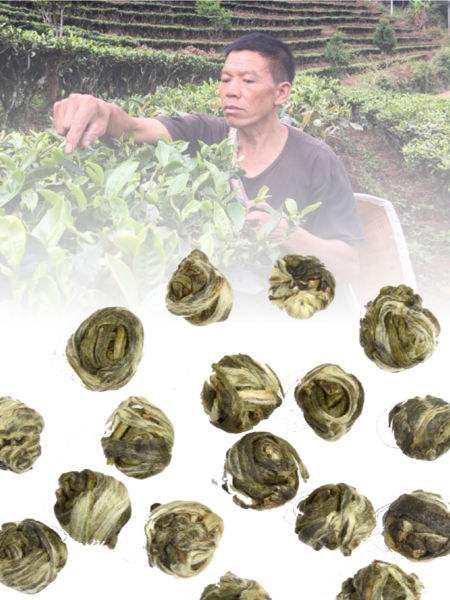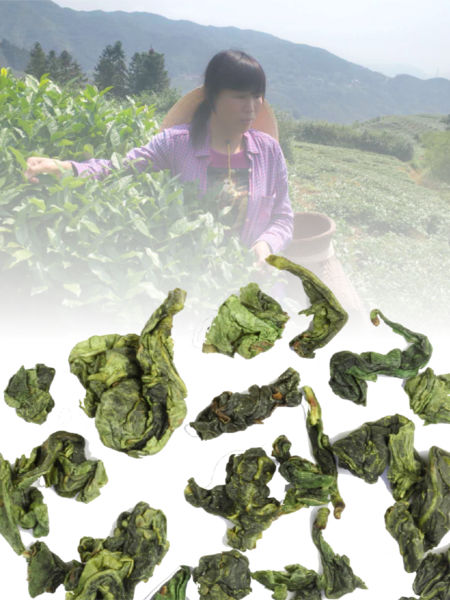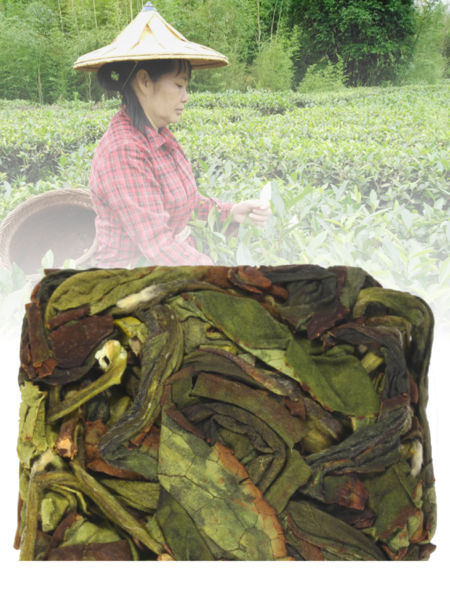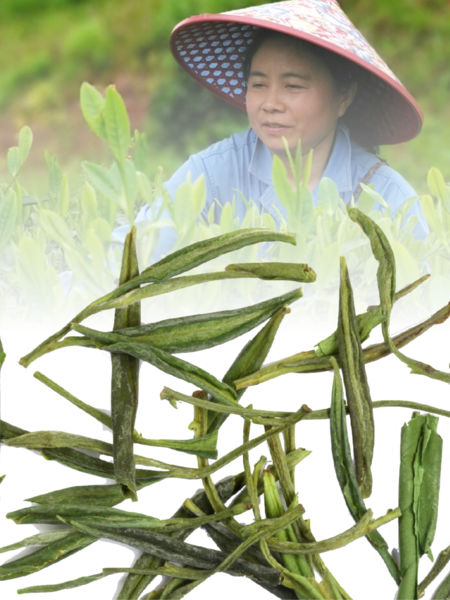Tea Spotlight: 4 More Fine Masters




Yin Hao Long Zhu
Yin Hao Long Zhu , or Silver Dragon Jasmine Pearl. Of the three most famous flowers that have been infused with Chinese tea (rose, osmanthus, and jasmine) perhaps the most intensely fragrant is the jasmine. Introduced to Fuzhou, jasmine gained popularity as a flower for the home and to use in women’s hair, during the Northern Song Dynasty (960-1127.) It was so popular that Fuzhou became known as “The City of Jasmine.”
Using jasmine with tea evolved considerably during the Ming Dynasty (1368-1644) until modern times when it fell out of favor. The industry was revived after 1950 and today, nearly 60% of all jasmine tea production is now done in Fujian.
ORIGIN: Hand plucked in shaped in April from leaves grown on an 8 to 10-year-old Fuding Big White Leaf cultivar which grows at 500 meters in Fujian, China. Our Yin Hao Long Zhu includes only 1 bud and 1 leaf which is often 7-10cm long. The Spring 2019 process, done over a 16 to 24-hour-period, was completed by June. Yin Hao is considered a premier category of jasmine-infused tea and indicates silvery tips in the pearls.
THE LEAF: The tea leaves are from bushes reserved for the white tea but processed as a green. The elegant leaves are hand rolled into small pearls, infused with freshly-picked jasmine flowers, then dried. This process is done from 3 to 5 times. Because jasmine blooms at night, this extends the work of tea processors through the night to take advantage of the most intense aroma of the flowers. Light firing or drying is common after each infusion to avoid mold from the moisture in the blooming flowers. Farmer Wang Ling Hui said that his whole work room is filled with the fragrance of jasmine and his hours of preparation are long, often until midnight during the summer, when the flowers open up to offer their scent.
HOW TO BREW: An extensive 7 infusions are possible from these elegant pearls of jasmine tea whose leaf buds unfurl elegantly into the cup. Suggested steeping time at 195°F. is 2 to 3 minutes although subsequent infusions may accommodate longer times. Farmer Hui suggests a porcelain or glass pot or cup to enjoy both the beautiful color of the brewed tea as the Long Zhu leaves unfurl to offer their nectar.
THE TASTE: The intoxicating fresh jasmine blossoms are matched by the delicately perfumed taste of the brewed tea. It has a light body, with a silky sweetness on the palate, and has a lovely lingering aftertaste. Absolutely a stand-alone tea to enjoy during the afternoon.
CAFFEINE: Moderate level.
Ma Liu Mi
A "Monkey Picked" variety of oolongs, our Ma Liu Mi is grown in Anxi County, known for its exceptional Tie Guan Yin (Iron Goddess) teas, a top tier Chinese tea. The term “monkey picked” comes from the legend that monkeys were once used to do the plucking due to their ability to climb to the highest point of tea trees. Modern-day tea pluckers use ropes tied around their waists to scale towering cliffs with ease if needed. Most tea trees are prevented from growing to their possible heights when farmers keep them at 3 to 5 ft. high so that pluckers can harvest the leaves comfortably.
ORIGIN: Our premier Ma Liu Mi selection comes from a farm in Fujian, China where Wang Xiang Feng has only recently joined her husband in his family’s tea trade. Their teas are grown at an elevation of 850 meters in the Wuji National Protection Area where permission must be granted to enter. Because of the restrictions, the area is pristine, with the freshest of air, greenest of tea trees, and richest soil, Wang Xiang Feng said. Despite these pluses, she cautioned, tea growing remains a challenge should the weather turns too cold or too rainy which impacts the tender tea buds and leaves.
THE LEAF: Ma Liu Mi is oolong roasted lightly by hand which results in intensely green leaves. Harvested in May of this year from 10-year-old trees, the plucking technique used was the standard 1 bud and top 2 or 3 leaves. Quite long, (8cm,) the leaves are curled after firing which makes the brewing of them quite a show visually and the fragrance is ambrosial.
HOW TO BREW: Steep in cool water, such as 180° F., for 2-3 minutes and expect 3 infusions. Err on the side of under brewing to preserve the delicate taste. To enjoy viewing the unfurling of the leaves, consider brewing in a glass teapot. However, to intensify the flavor, a small Yixing teapot packed with leaves is ideal to elicit every edge of flavor./p>
THE TASTE: The liquor is a clear light yellow-green matched by a light flavor that is multi-layered and intricate. The aftertaste is lingering and floral, a wonderful endnote that begins with the characteristic orchid fragrance in both the dried and brewed leaves. Because the processing of this selection uses the traditional Zheng Chao style most akin to true Tie Guan Yin, our Ma Liu Mi offers a cup that is both smoothly elegant and satisfyingly brisk. An excellent afternoon tea, it is flavorful yet not too stimulating.
CAFFEINE: Moderate level. .
Zhang Ping Shui Xian
When most tea lovers think of tea bricks, they recall tea traders traveling for months over the ancient Silk Road relying upon this technique as a preservative of their pricey teas. Like in ancient times, modern puerh producers use this same technique to age their teas for weeks to years in bricks or rounds. Zhang Ping Shui Xian is not, however, a puerh, but a highly-aromatic oolong whose long leaves are shaped and packed into signature square bricks to heighten both flavor and fragrance./p>
ORIGIN: Farmer Yuan Xiao Zhen has been working on her family’s farm in Fujian Province for a decade and tells us she likes the brick-shaping process of her family’s tea production most of all. The fresh leaves, which grow at an elevation of 800 meters on trees now 15-years-old, have an intensely floral fragrance that remains even after shaped into bricks. It's name has a meaning of "Water Immortals/Sprites"
THE LEAF: Harvested in early May, Shui Xian belongs to the Tribute Tea category. The leaves are hand-picked, and include 3 to 4 open leaves and the leaf bud. The leaves are quite long, 10cm, and are put through a low-fire process for 15 minutes then a roasting that may last up to 4 hours. This seals in the exquisite flavor and aroma of the leaves as they are shaped into the square bricks completely by hand.
HOW TO BREW: While many oolongs are brewed at cooler temperatures, Farmer Zhen suggests using a gaiwan (covered cup) for brewing at boiling (212°F.) for 2-3 minutes to capture both the intense color and taste of this unusual tea. The color in the cup will be similar to the orange/amber color of a traditional oolong, yet the fragrance is more like orchids or narcissus. Up to 3 infusions are possible.
THE TASTE: The taste notes unfurl one after the other, delicately at first like spring flowers and honey then segue to a more intensely floral and vegetal combination of scents and flavors. A superb stand-alone tea to savor by yourself or share with someone special, this is an oolong with a distinctively mellow smoothness, a long-lasting aftertaste, accompanied by highly fragrant aromas.
CAFFEINE: High level.
Meng Ding Huang Ya
In a small, rare category, Meng Ding Huang Ya is a yellow (huang) tea, placed in the pantheon between whites and greens for their delicate yet distinctively rich and smooth taste that recalls the sweet nuttiness of hazelnuts. Its name translates to Misty peak | Yellow Bird
ORIGIN: For more than two millennia, from the Han Dynasty on, this exquisite yellow tea has grown along Mont Meng aka Hidden Peak. The attitude, the misty fog, the terroir, all have contributed to its distinctively soft flavor profile. Meng Ding Huang Ya’s place in history was guaranteed during the Tang Dynasty when it was designated an Imperial Tribute Tea.
Our selection is grown in the Sichuan Province of China under the supervision of tea farmer Gu Zhi Xin, who climbs the arduous trails of the mountain, up to 800 meters, every workday. During the rainy season, the muddy, slippery wet trails are hazardous, she says, but the majority of the days are bright and clear, affording her the dual pleasures of fresh morning air and exhilarating exercise as she climbs, the key to her own good health, she claims.
THE LEAF: The 3cm, elegantly-straight green leaves are atypical for the Meng Ding tea category which is known more for its curled shapes. The leaf buds are yellow and plentiful. Grown on 30-year-old trees, these leaves are plucked in late April and early May, then fired at least 4 times to extract the moisture before the final sorting and shaping. What results is a fruity dry fragrance in the dried leaves that promises a rounded tasting pleasure from the cup.
HOW TO BREW: Water quality is essential for an exceptional tea like Meng Ding Huang Ya: only the purest (and local if you can find it) spring water will do. Steep at 170°F. for 2-3 minutes and expect at least 3 infusions. To fully enjoy the clarity of its yellow color, consider a glass vessel for brewing and/or glass cup for your tea-drinking pleasure.
TASTE: The flavor is toasty-nutty with warm overtones that provides a full-mouth feel. Enjoy this tea plain, steeped quickly, with slightly longer times for subsequent infusions. An ideal afternoon tea, it is refreshing but not overly stimulating.
CAFFEINE: Moderate level.
